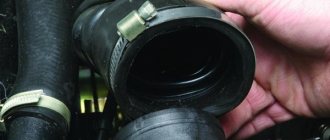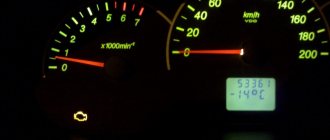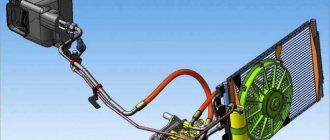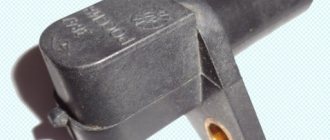Mass air flow sensor, what kind of “beast”?
The Priora air flow sensor, as its name suggests, generates the amount of air required to compose the air-fuel mixture. The air passing through the sensor is counted by a sensitive element located inside the sensor. The air flow sensor sends all measurements taken to the electronic engine control unit, which in turn adjusts the fuel and air parameters to supply the cylinders with a fuel mixture that has already been prepared for normal operation of the internal combustion engine.
Design
The mass air flow sensor consists of the following elements:
- Frame;
- Electronic element;
- Filter;
- Sensitive part;
Why it is not recommended to clean the mass air flow sensor on a Priora and how to do it correctly
The mass air flow sensor cannot be repaired, so if it malfunctions, it must be replaced. However, there is an exception to this: if the DTVV fails, then the thermistor can be replaced by selecting the appropriate type depending on the resistance. If the sensor begins to show incorrect values, which happens if the silicon crystal is dirty, then it can be cleaned, but it is important to understand that such manipulations are only temporary, and soon the possibility of recurrence of problems with the mass air flow sensor cannot be ruled out.
Why is it not recommended to clean the film mass air flow sensor used on Priora? Let's look at this issue in depth. If you decide to clean the mass air flow sensor on a Priora, where a film type of product is used, then it is important to know the following:
- Such substances are strictly contraindicated for use for flushing. Like ketones and esters. This is due to the fact that they dissolve the compound layer that covers not only the board, but also the platinum branches connecting the crystal to the processor on the board. If the compound is dissolved, then thin branches (their thickness is less than 0.01 mm) will be damaged by passing air.
- When silicon comes into contact with ketones and esters, the wafer cools, which can ultimately be damaged.
- When exposed to the substances described above, the coating on the polymer film, which is located on the crystal itself, is also washed off. If the coating is washed off, the film is simply deformed.
- It is strictly contraindicated to blow or clean the product with a compressor (that is, you cannot apply a stream of compressed air to the crystal area), as this will lead to deformation of the branches.
If you are convinced that your air flow sensor on the Priora needs to be cleaned, then it is recommended to perform the procedure correctly. To do this, it is best to use the following substances:
- WD-40;
- "Liquid key";
- isopropyl alcohol;
- special liquid for cleaning the air flow sensor.
It is best to use a special cleaning liquid, but it is naturally more expensive than other cleaners. That is why, when choosing among budget cleaners, you need to give preference to isopropyl alcohol, since, unlike WD-40 and Liquid Key, it does not form an oil film on the surface, which will also need to be washed off. Preparations that are intended for cleaning carburetors and contain acetones, ketones and ethers are strictly contraindicated for use in cleaning the air flow sensor on a Priora.
This is interesting! Washing should be done using a syringe and a needle, from which you need to pour a thin stream onto the surface of the sensitive element.
DMRV Priora
The Priora installed two types of mass air flow sensors. The first sensors were less reliable and quickly damaged. With the transition to the E-GAZ system, more reliable and durable frequency sensors began to be installed in cars.
The external differences between the sensors are shown below:
On the left is a Priora sensor without the E-GAS system, on the right is a frequency sensor for the E-GAS system
Types of mass air flow sensors and the principle of their operation
There are two types of mass air flow sensors, which differ in design, but their operating principle is identical. These flow meters have the corresponding names:
- Threaded air flow sensor.
The principle of its operation is based on changing the resistance of a thread-like element made of platinum and connected to an electrical circuit. Voltage is applied to the thread, which causes it to heat up. The temperature of the filament is about 120-150 degrees, and it decreases as air passes through while the engine is running. The more the damper opens, the greater the air flow, the more the filament temperature drops accordingly. It is due to the voltage drop on the filament (from a change in the temperature of the passing air) that the quantitative composition of the oxygen sucked into the intake manifold is determined. - Film mass air flow sensors or hot-wire ones
differ from the previous version in that they are more accurate, which has a positive effect on engine performance. The operating principle of such products is similar to the previous version, only they already have two platinum thermistors and one heating or compensation resistor (located between them). Thermistors work on a similar principle as filament sensors, that is, air passes through, cools the filaments, which leads to a decrease in resistance, and as a result, the voltage drops. The second thread is a heating resistor, which is located between the first and third threads, needed to heat the air. The result is the following picture: the first thread is cooled by the incoming air, and its resistance changes. The air that is already heated approaches the second thread, for which the resistor is responsible. Based on the change in the resistance of the first and second threads, the quantitative composition of the air entering the engine manifold is calculated. Due to this device, film products are not only more accurate, but also multifunctional, that is, they measure the amount of not only direct, but also reverse air flow.
It is important to note that instead of three threads, a plate (anemometer) made of silicon crystal can be used (plays the role of a heating resistor). Such a crystal is coated with several layers of platinum coating (thermal resistance), and performs similar functions as described above. Below is a diagram of a film sensor based on a silicon crystal.
The crystal is placed inside a protective casing, which is placed in a special channel (labyrinth). Moreover, the labyrinth has a special geometry, which makes it possible to take temperature measurements not only from the input flow, but also from the reflected flow. The specificity of the channel is created in such a way that the formation of dust and dirt deposits on the crystal is eliminated. The service life of products does not depend on their quality, but on factors such as the serviceability of the car’s crankcase gas exhaust system and the frequency of replacing the air filter. If the filter is not changed after 50 thousand km, then naturally not only the mass air flow sensor will suffer from this.
This is interesting! Film-type air flow sensors cannot be cleaned, but practice shows the opposite. If there are contaminants on the silicon crystal (sensitive element) of the film MRI sensor, they can be removed with special substances.
From the design and operating principle of both types of mass flow sensors, you can independently draw appropriate conclusions about their advantages and disadvantages. Naturally, the first type of sensors also has advantages:
- reliability;
- unpretentiousness.
And although there are not many advantages, they play an important role, which is reflected in their service life. Film flow meters, in addition to increased accuracy, are characterized by the ability to measure reverse air flow. Reverse flow occurs when the intake valves operate. However, film products have one serious drawback - they are not designed for cleaning when dirty. The reasons for their contamination are factors such as oil getting onto the surface, which comes from the crankcase gas system along with the reverse air flow, as well as contamination from the filter, which car owners change irregularly, although this must be done no later than every 20 thousand km. (in individual cases earlier).
This is interesting! Knowing the types of mass air flow sensors, it should be noted that Priors are equipped with products of the second type, that is, film ones.
The flowmeters are designed using a temperature sensor. It is called the DTVV intake air temperature sensor, which is a thermistor with a resistance dependent on temperature.
Depending on the temperature of the incoming air, the ECU adjusts the composition of the mixture (if the air is cold, the mixture is enriched, and when heated air enters, it normalizes).
Symptoms of a problem
Since the sensor is electronic and if it fails, the “CheckEngine” lamp will necessarily light up on the car’s dashboard. But not in all cases the sensor fails completely. When the sensor is dirty or old, it begins to incorrectly read the air volume, which significantly affects the formation of the air-fuel mixture.
In case of such a breakdown, the “CheckEngine” warning light will not light up.
Signs:
- Engine speed fluctuates;
- Difficulty starting in all temperature conditions of the internal combustion engine;
- Increased fuel consumption;
- Uneven engine operation at idle;
- Loss of vehicle dynamics;
If you find such malfunctions on your car, first of all you need to inspect the air flow sensor.
Which mass air flow sensor to install on Priora
If the procedure for cleaning the MAF sensor element does not result in improved engine performance, and when checking the product, the multimeter shows inflated results, then only replacement will help. You should know that the mass air flow sensor costs from 3,500 to 5,000 rubles, and therefore it is the most expensive among the executive bodies of the ECU on a car. However, driving with a faulty product is also dangerous, because in addition to increased fuel consumption, the life of the internal combustion engine is reduced.
If there is a need to replace the mass air flow sensor on a Priora, then it is important to know that such sensors are available in different versions. You need to choose exactly the type that is installed on your car. And although all models are structurally the same, they still have differences in calibration, that is, in the readings that they transmit to the computer. They are produced by Bosch. There are the following types of MVR sensors on Priora, which are marked as follows:
- 0280218116;
- 0280218164;
- 0280218225;
- 0280218037.
Among all these sensors, there are no worse or better ones, and their main difference is calibration, that is, the shape of the signal that is perceived by the ECU. By marking, the sensors are not associated with the vehicle, but with the type of controller or ECU. Below is a table showing different models of mass air flow sensors used for certain types of controllers.
Once again, it is important to note that mass air flow sensors on Priora are not interchangeable, and you only need to install the type of device that was on the car.
This is interesting! When purchasing products, pay attention to the fastening parts that secure the sensor to the cylindrical body. To avoid buying a fake, you need to choose products with a ribbed surface, as shown in the photo below.
The packaging of a new product must contain a hologram. And it is precisely such devices that do not need to be checked before purchasing them.
In conclusion, it is worth noting once again the importance of the mass air flow sensor on a car. This sensor rarely fails completely, and most often, the malfunction manifests itself in the form of an increase in the output voltage supplied to the ECU. This is a slight increase (from 0.02 to 0.05V), but it is precisely such deviations that lead to the supply of inaccurate values of the incoming air mass to the collector. Monitor the serviceability of this product, and in case of the first signs of malfunction, carry out replacement or possible repairs in the form of cleaning.
Examination
Checking the mass air flow sensor is carried out using a multimeter, diagnostic tool or oscilloscope. In most cases, car enthusiasts do not have equipment that can diagnose sensor failure.
In this case, let's consider checking with a regular multimeter, which almost every driver has or is otherwise inexpensive.
Checking the mass air flow sensor with a multimeter can only be done with a sensor that is installed on an engine without an E-GAS system. The frequency sensor installed in conjunction with the electronic throttle cannot be checked using a multimeter. Checking such a sensor is carried out with a diagnostic device using ADC channels or using a diagram on an oscilloscope.
You can also check the frequency sensor using the ELM327 diagnostic tool; read how to do this in our article.
Verification Process
To check the sensor you will need two needles and a multimeter. The principle of determining the performance of the mass air flow sensor is carried out by measuring the voltage between the contacts.
Checking the circuit
Initially, the sensor's power circuit is checked.
- We switch the multimeter to the DC voltage measuring mode at 20V.
- Remove the connector from the mass air flow sensor.
- Turn on the ignition on the car.
- We connect one of the multimeter leads to the motor housing, and the second to Pin No. 2 on the connector (there is a numbering of contacts on the block). The voltage at Pin No. 2 must be at least 12V.
- We carry out the same procedure with Conclusion No. 4. The voltage at Pin No. 4 must be at least 5V.
If the readings do not match and are significantly less than those indicated, you should check the battery, computer and power supply circuit of the mass air flow sensor.
Sensor check
Let's start checking the sensor; to do this, connect the mass air flow sensor connector if it is removed.
- We set the DC voltage measurement limit on the multimeter to 2V or 2000mV (in different versions of the multimeter, this value is indicated differently).
- We measure the voltage between terminals 1 and 3 with the car ignition on and off. We check the readings with the table below.
| Voltage (V) | State |
| 0.99…1.01 | Condition of the new sensor |
| 1.01…1.02 | The sensor is in good condition |
| 1.02…1.03 | Normal state of the air flow sensor |
| 1.03…1.04 | Needs replacement soon |
| 1.04…1.05 | The sensor practically does not work, it needs replacement |
| 1.05...and higher | The sensor is completely faulty and urgently needs replacement |
Also, one of the good checks of the mass air flow sensor is to replace it with a known good one, for example from another similar car.
Overview and characteristics of the mass air flow sensor
The sensor is connected to the electrical harness and is located in the intake tract. The signal from the mass air flow sensor is a direct current, which has its own voltage. The magnitude of the current depends on the movement of air in the Priora that has passed through the sensor. The Priora mass air flow sensor includes:
Components
thermoelement. The first determines the temperature in the environment. Heating the air to the desired specific temperature is assigned to the next two thermoelements.
During the measurement of electrical power, the determination of the consumed air begins to occur. Electric power maintains the temperature at the desired level.
The filter that is installed in the Priora mass air flow sensor prevents large particles from entering the sensor housing. If this happens, the thermocouples may fail. It also has the function of cutting air to ensure even distribution of air. The filter is fixed with a ring intended for it in the inlet flange.
There is one rubber ring on each side of the housing for sealing. This is done to prevent air from being sucked in. Great importance should be paid to the seal ring located between the housing and the outlet flange located in the sensor. If air begins to be sucked in, the system will not be able to take this into account, as a result of which the fuel mixture will become leaner. In this case, it is impossible to ensure maximum engine performance. It will be difficult to know that this is the problem with poor sensor performance. This will be difficult to do even with measuring instruments.
To remove the mass air flow sensor, turn off the ignition and then disconnect the sensor from the connector. Disconnect the air hose connected to it. Then, unscrew a couple of bolts and disconnect it from the air filter. You need to put the mass air flow sensor in place in the reverse order.
If foreign particles get into the mass flow sensor housing, it may fail. The MAF is a precise measuring device and, as has already been proven, does not tolerate anything hitting its body. The sensor on the car can be wire or film.
Replacement
- Remove the negative terminal from the battery.
- Remove the connector from the mass air flow sensor.
- Unscrew the intake corrugation clamp from the sensor.
- Unscrew the two 10mm wrench bolts.
- We take out the sensor and install a new one in the reverse order.
- Don’t forget to remove the rubber ring from the old sensor and install it on the new one.
How to remove and replace the mass air flow sensor on a Priora: which sensor to install on the car
The process of removing the mass air flow sensor on a Priora is not complicated, but it is important to understand that its dismantling must be performed not only when replacing it, but also if it is planned to be cleaned. Instructions for removing the mass air flow sensor are as follows:
- Disconnect the minus terminal from the battery. This is necessary in order to reset the ECU adaptation, or in simple words, reset the memory.
- The clamp securing the air duct pipe to the sensor is loosened.
- Disconnect the air duct pipe.
- Remove the power supply by prying the lock from below.
- Using a key set to “10”, you need to unscrew the two bolts securing the device to the filter housing.
- Remove the product so that it can be replaced, repaired or cleaned. However, it is worth noting once again that even if the cleaning is done correctly, the sensor will not last long after such repairs, and soon it will still need to be replaced.
This completes the removal process. Installation of a new product or the same sensor is performed in the same way. It is only important to take into account that if a new sensor is installed, then the O-ring must be removed from the old one and put on the new one. When reinstalling, you must pay attention to the arrow. It is in the direction of the arrow that the product must be placed. The bolts must be tightened with a force of 4-6 Nm, which will eliminate the possibility of damage to the fastening part in the air filter housing, and at the same time ensure sufficient pressure on the product.
This is interesting! It is recommended to remove the mass air flow sensor even if you have a special screwdriver for unscrewing the screws securing the sensor to the body. This is necessary in order to clean not only the sensitive element, but the housing of the ventilation duct with the mesh, on which a considerable amount of dirt has probably accumulated.
Checking the mass air flow sensor using a multimeter
It is advisable to use a digital multimeter, with measurement accuracy up to hundredths of a volt in the range of 2, 10, or 20 V DC voltage.
- Checking the supply voltage from the ECU controller is carried out with the connector disconnected and the ignition on, without starting the engine. At contacts No. 2 and 4 there should be 12 V and 5 V, respectively, relative to contact No. 3 (ground). This is the supply voltage of the device and the variable resistor with a platinum thread.
- Checking the signal voltage at rest is carried out with the connector connected, the ignition on, and the engine not started. It is necessary to firmly insert the probes from the back of the connector into contacts Nos. 3 and 5.
- A working sensor will show 1 volt ± 0.02 V. If the voltage is outside the error of 0.05 V, the sensor is faulty.
Why does a faulty mass air flow sensor affect the operation of the internal combustion engine?
To form the correct proportions of the fuel-air mixture (the stoichiometric ratio per 1 kg of gasoline is 14.7 kg of air), the ECU controller needs to know the mass of air entering the combustion chambers. It is this data in the form of a variable voltage value that comes from the mass air flow sensor. The calibration graph of a working flow meter on a Priora shows that with the throttle valve closed (air flow 0 kg/hour), the MAF ADC voltage is approximately 1 V.
The graph also shows the accuracy with which (up to 1/1000 volt) the signal readings change with increasing air flow. This indicates the high sensitivity of the flow meter sensor system. The slightest malfunction and the data will be distorted.
As a consequence, there is a violation of the formation regime of the fuel mixture and a sharp deterioration in the characteristics of the internal combustion engine.











